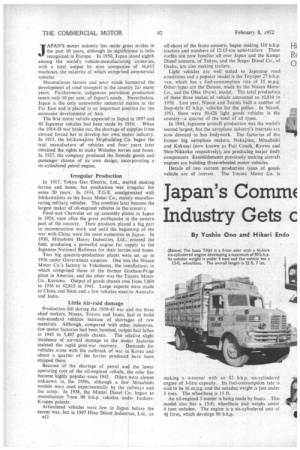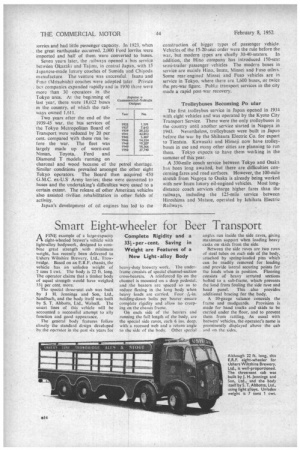Japan's Commercial Motor Industry Gets on its Feet
Page 46

Page 47

Page 48

If you've noticed an error in this article please click here to report it so we can fix it.
JAPAN'S motor industry has made great strides in the past 10 years, althoughits significance is little recognized in Europe. In 1950, Japan stood eighth among the world's vehicle-manufacturing countries, with a total output by nine companies of 36,613 machines, the majority of which comprised commercial vehicles
Mountainous terrain and poor roads hampered the development of road transport in the country for many years. Furthermore, indigenous petroleum production meets only 10 per cent. of Japan's needs. Nevertheless, Japan is the only noteworthy industrial nation in the Far East and is placed in an important position for the economic development of Asia.
The first motor vehicle appeared in Japan in 1897 and 40 Japanese vehicles had been made by 1910. When the 1914-18 war broke out, the shortage of supplies from abroad forced her to develop her own motor industry. In 1915, the Ishikawajima Shipbuilding Co. began the trial manufacture of vehicles and four years later obtained the rights to make Wolseley lorries and buses. In 1927, the company produced the Sumida goods and passenger chassis of its own design, incorporating a six-cylindered petrol engine.
Irregular Production
In 1917, Tokyo Gas Electric, Ltd., started making lorries and buses, but production was irregular for some 20 years. In 1934, T.G.E. amalgamated with Ishikawajima as the Isuzu Motor Co., mainly manufacturing military vehicles. The combine later became the largest maker of oil-engined vehicles in the country.
Ford and Chevrolet set up assembly plants in Japan in 1924, soon after the great earthquake in the eastern part of the country. Their products played a big part in reconstruction work and until the beginning of the war with China were the most numerous in Japan. In 1930, Mitsubishi Heavy Industries, Ltd., entered the field, producing a powerful engine for supply to the Japanese National Railways for their lorries and buses.
Two big quantity-production plants were set up in 1936 under Government auspices. One was the Nissan Motor Co.'s factory in Yokohama, the installations in which comprised those of the former Graham-Pkige plant in America, and the other was the Toyota Motor Co., Koromo. Output of goods chassis rose from 5,004 in 1936 to 42,813 in 1941. Large exports were made to China and Siam and a few vehicles went to Australia and India.
Little Air-raid damage Production fell during the 1939-45 war and the three chief makers, Nissan, Toyota and Isuzu, had to build sub-standard vehicles because of shortages of raw materials. Although, compared with other industries, few motor factories had been bombed, output had fallen
in 1945 to 5,487 goods chassis. The relative slight incidence of air-raid damage to the motor factories assisted the rapid post-war recovery. Demands for vehicles arose with the outbreak of war in Korea and about a quarter of the lorries produced have been shipped there.
Because of the shortage of petrol and the lower operating cost of the oil-engined vehicle, the oiler has become highly popular since 1945. Oilers were almost unknown in, the 1930s, although a few Mitsubishi models were used experimentally by the railways and the army. In 1938, the Minzei Diesel Co. began to manufacture 7-ton 90 b.h.p. vehicles under JunkersKrupps patents.
Articulated vehicles were few in Japan before the recent war, but in 1947 Hino Diesel Industries, Ltd., an B12 off-shoot of the Isuzu concern, began making 110 b.h.p. tractors and numbers of 12-15-ton semi-trailers. These outfits are now familiar all over Japan a.nd the Kongo Diesel concern, of Tokyo, and the Ikegai Diesel Co., of Osaka, are also making trailers.
Light vehicles are well suited to Japanese road conditions and a popular model is the Toyopet 27 b.h.p. van, which has a fuel-consumption rate of 35 m.p.g. Other types are the Datsun, made by the Nissan Motor Co., and the Ohta 10-cwt. model. The total production of these three makes of vehicle amounted to 10,810 in 1950. Last year, Nissan and Toyota built a number of Jeep-style 82 b.h.p vehicles for the police. In March, 1951, there were 50,426 light goods vehicles in the country—a quarter of the total of all types.
In 1944, Japanese aircraft production was the world's second largest, but the aeroplane industry's interests are now devoted to bus bodywork. The factories of the former big aeroplane makers, Nakajima, Mitsubishi and Kokusai (now known as Fuji Coach, Ryowa and Shin-Nikkoku respectively), are producing major body components Establishments previously making aircraft engines are building three-wheeled motor vehicles.
Details of two current production types of goods vehicle are of interest. The Toyota Motor Co. is making a 4-tonner with an 82 b.h.p. six-cylindered engine of 3-litre capacity. Its fuel-consumption rate is said to be 16 m.p.g. and the unladen weight is just under 3 tons. The wheelbase is 13 ft. .
An oil-engined 5-tonner is being made by Isuzu. This model also has a 13-ft. wheelbase and weighs under 4 tons unladen. The engine is a six-cylindered unit of 4i litres, which develops 90 b.h.p. .
At present, only SO per cent. of Japan's production capacity is being used, because of raw-material shortages and the closure of Chinese
markets. Japan is seeking new export markets in south-east Asia, India, Pakistan and Latin America. In 1950, about 1,500 vehicles were shipped to Siam, among them some Isuzu buses for service in Bangkok. A hundred other vehicles were exported to Brazil and Argentina.
As only 1 per cent. of -the highways in Japan have hard surfaces, road transport pIayi little part in long-distance haulage. Motor vehicles are mainly used for short-distance work in the main. cities. The 1951 total of lorries in use was 155,486 and there were, in addition, 120,523 threewheelers.
In the 1920s and 1930s, a number of small hauliers operated in the country and 500 of them amalgamated in 1943 in the Nippon Express Co.., Ltd. This undertaking is the largest road transport concern in Japan and owns over 10,000 vehicles, most of which are Japanese.
Until, 1939, most of the lorries in use were Fords, Chevrolets and Dodges. In the• 1914-18 war, the Japanese army tried to depend on home-manufactured vehicles, but these were far from reliable and, the Ministry of Commerce and Industry helped the motor industry to improve designs. Large numbers of Japanese-made vehicles were available in 1931-32 for military operations in Manchuria. At the end of the 1939-45 war, many U.S. Army vehicles were released to Japan and these were a great help to the country's immediate post-war economy. The first regular city bus services began in Tokyo in 1918, but the vehicles were adapted
rorries and had little passenger capacity. In 1923, when the great earthquake occurred, 2,000 Ford lorribs were imported and half of them were converted to buses.
Seven years later, the i-ailways opened a bus service between Okazaki and Taint', in central Japan, with 15 Japanese-made luxury coaches of Surnida and Chiyoda manufacture. The venture was successful. Isuzu and Fos!) (Mitsubishi) coaches were adopted later. Private bc companies expanded rapidly and in 1930 thore were more than 30 operators in the Tokyo area. Al. the begraning of last year, there were 18,022 buses in the country, of which the railways owned 1,611.
Two years after the end of the 1939-45 war, the bus services of the Tokyo Metropolitan Board of Transport were reduced by 20 per cent, compared with those run before the war. The fleet was largely made up of worn-out Nissan, Toyota, Ford and Diamond T Models running on charcoal and wood because of the petrol shortage: Similar conditions prevailed amongst the other eight Tokyo operators. The Board then acquired 450 G.M.C. ex-US Army lorries; these were converted to buses and the undertaking's difficulties were cased to a certain extent. The release of other American vehicles also assisted civilian rehabilitation in other fields of activity.
Japan's development of oil engines has led to the
Japan., Cklmmercial -Vehicle Output
YcarNo
1955 1,181 1937 7,613 1939
29,233
1941 42,813 1945 5,487 1946 14,324 1448 1%207 1949 18,366 1950 27,740
construction of bigger types of passenger vehicle. Vehicles of the 15-20-seat order were the rule before the
war, but modern types are chiefly 30-40-seaters. In addition, the Hino company has introduced 150-seat semi-trailer passenger vehicles The modern buses in service are mainly Hino, Isuzu, Minsei and Fuso oilers. Some rear. engined Minsei and Fuso vehicles are in service in Tokyo, where there are 1,600 buses, or twice the pre-war figure. Pubke transport services in the city made a rapid postwar recovery.
Trolleybuses Becoming Po ular The first trolleybus service in Japan opened in 1934 with eight vehicles and was operated by the Kyoto City Transport Service. These were the only trolleybuses in the country until another service started in Nagoya in 1943, Nevertheless, troileybuses were built in Japan before the war by the Shibaura Electric Co. for export to Tientsin. Kawasaki and Himeji now have trolleybuses in use and many other cities are planning to run
them. Tokyo expects to have them working in the summer of this year.
A 330-mile coach service between Tokyo and Osaka has been long awaited, but there are difficulties concerning fares and road surfaces. However, the 100-mile stretch from Nagoya to Osaka is already being worked with new Isuzu luxury oil-engined vehicles. Most longdistance coach services charge higher fares than the railways, including • the 125-mile service between Hiroshima and Matstie, operated by lchihata Electric Railways.




























































































